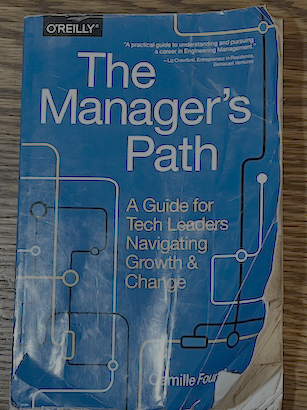Quick Thoughts on The Manager’s Path: A Guide for Tech Leaders Navigating Growth & Change

Fournier, Camille. The Manager’s Path: A Guide for Tech Leaders Navigating Growth and Change (1st edition). O’Reilly Media, 2017.
This book is also featured on my recommendations for an engineers path to leadership.
My Review: 5/5
If you are in the software engineering profession and you want a guide to navigate your career, this book is a must-read.
My experience has been that The Manager’s Path is an oft cited and oft recommended leadership book for software engineers considering how to navigate their careers. This book has everything you could hope for, but is especially relevant for leaders in the midst of a career transition as detailed below. This book escaped my Goodreads review migration primarily because I was always “in the middle” of reading it and never stopped to complete a review on that site.
I think I was recommended this book when I first inquired about advancing in my career to a tech lead position. Initially, I started with the lessons on mentoring, progressing to the chapters on managing projects and teams. Even now, as I’ve completed almost six years as an engineering manager, I still find myself referring to the lessons this book contains. As you can see from the above image, it is one of my most thumbed books.
Fournier’s experience and writing to software engineer audience includes specific considerations of leading in the software engineering domain, which is still a relatively young profession. To emphasize this point, the chapter progression below provides guidance and relevance no matter where you are in your career progression.
Mentoring -> Tech Lead -> Managing People -> Managing a Team -> Managing Multiple Teams -> Managing Managers -> The Big Leagues
Key Sections
There are multiple “keeping it real” sections that contrast what you think a promotion means you’ll be doing vs. what you’ll actually be doing.
You think you want to become a tech lead because then everyone will finally listen to your opinion on tabs vs. spaces, but now you have to lead a team you don’t directly manage.
You think you want to become a manager because then you’ll get to prioritize those platform upgrades or finally adopt a new deployment pipeline, only to find out that the business expects results from you—oh, and the tech lead you had hoped would lead the project suddenly took an offer outside the company.
Another aspect that this book covers is that when times are tough, when you’re uncertain, its natural to reach for what you were an expert in—for what you’re comfortable doing.
This is a regression; every promotion and move up the ladder means you will be expected to perform the responsibilities of that role—not getting in your team’s way as you try to do your old job. But don’t forget that leadership is a practice of credibility, and this book offers many great examples of staying current without being in the way.
I know a review should include some counterpoint to avoid the perception of being snowed, but I think this book will continue to be one of my favorites. Perhaps the only thing it’s missing is complemented by the author’s recommendation of two other great books: Marcus Buckingham’s First, Break All the Rules: What the World’s Greatest Managers Do Differently and What Got You Here Won’t Get You There.
Significant Revisions
- Jan 18th, 2025 Originally published on https://www.jsrowe.com with uid 3B4019BA-FC41-4645-BD1A-298858300444
- Jan 12th, 2025 Draft created